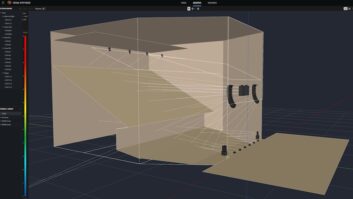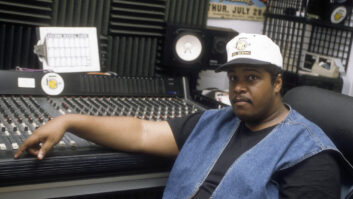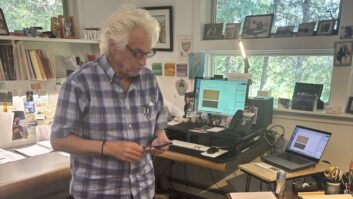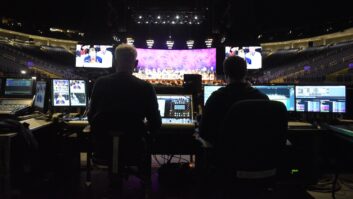Since their formation in 1969, the British band King Crimson has been questing for new frontiers. Now, 30 years down the line, they’ve delved into the realm of DVD with Deja VROOOM. This innovative and inventive DVD includes 19 musical selections from different parts of their career, performed by a double-trio version of King Crimson and presented in 5.1 DTS surround sound. There’s video footage from concerts in 1969, ’71, ’73 and ’95; KC bassist Tony Levin’s Super 8 “Road Movies” of the band on tour in the mid-’90s; an interactive game that allows the user to create a “dream” KC band from several different lineups; and insightful commentaries on the group’s history and music from Robert Fripp, co-founder, guitarist and only member of every incarnation of the band. There’s very little that KC has overlooked on this disc, which intertwines cutting-edge technology with their provocative music.
The band previously had very little involvement in the visual domain, outside of a couple music and concert videos. So why the sudden interest in DVD? “Because it was possible,” answers Fripp, while in Los Angeles for the debut of the disc. “The concept of King Crimson as a double-trio appeared to me in a flash, when I was driving by our village church in England. The insight was a trio playing on both sides of the stage. You can’t put that on stereo; you have to have something like a surround facility to convey the music as conceived.
“I’ve heard a number of surround sound approaches with DTS. The music, which is conceived specifically for DVD, is very different from music which is being remastered on DVD. Even the music remastered on DVD benefits from the DTS surround sound. The oversampling with DTS is so impressive-I’ve heard some 1960s Tamla/Motown, and it sounded like it could have been recorded yesterday. The DTS system is quite apart from any surround sound facility as a way of enhancing music. It’s worth doing it just for that, even if the music wasn’t originally conceived that way.”
Incredible sound and sharp images are well-known attributes of the DVD format, but there are other qualities the KC DVD employs that make the disc unique. On the song “VROOOM VROOOM,” for example, the disc features video of all six members of the band captured in sync with a seventh view showing them all together onstage. Any of the musicians can be selected to be seen individually, with their musical part becoming prominent on the center speaker of the surround sound configuration, allowing the listener/viewer to change the visual and musical perspective at will.
David Singleton, an engineer and director of Discipline Global Mobile, Fripp’s record company, notes, “I created seven separate mixes for ‘VROOOM VROOOM.’ I’d assumed initially that it could be done discretely, instead of me having to do seven complete mixes, but it didn’t work out that way. Due to space limitations it’s the only selection that has this feature.” Singleton says that Deja VROOOM is his first work in surround.
“The original 48 [tracks of] ADAT were mixed to six ADAT tracks for the 5.1,” he notes. “Because the originals were on ADAT, we used an 02R-the Yamaha digital desk-which has surround sound capability. Also you get a digital optical link from an ADAT to an 02R so you don’t have to use the D-to-A converters on the ADAT.
“We had a lot of discussions about how to use the surround sound,” Singleton continues. “A lot of other projects that have used it seem to have the music in the front three speakers with the ambience or crowd behind you. We felt that the six-piece version of King Crimson always was very limited in stereo; it was quite hard to squeeze them fully into it. So we thought that rather than doing that, what we would do is open it up and effectively sit you down in middle of the sound. Because there are two drummers, it opened up a complete new possibility for panning. So we got one drummer left-front to left-back down your left-hand side, and one drummer down your right-hand side. Once you do that, you’ve sort of liberated yourself from the standard stereo perspective. The voice is in the center-front, the two guitarists diagonally across the left-front and right-front speaker. The bass should be flat and aptly smack overhead and equal in all four speakers. Trey Gunn, the Warr guitar player, is behind you in the rear two speakers.
“That idea was fine, except the way people configure their systems, and where they sit, is a movable feast. Having established that basic panning pattern, we tried to make it so that it made sense to anyone who listened to it, and that it wouldn’t change that much when you moved around.”
All went smoothly with the project until Singleton started working on the segment titled “21st Century Schizoid Band.” “Then all sanity went completely out the window,” he says with a chuckle. This interactive section lets KC fans mix and match the rhythm section, vocalist and lead instrumentalist from four different versions of the band (’69, ’71, ’74 and ’96) to create 64 different versions of the group’s “21st Century Schizoid Man” (off the first KC album). “That was a mistake,” Singleton says wryly. “I just mentioned the idea, because it’s something the fans all talk about: ‘Who’s your favorite singer in King Crimson, guitarist, or drummer, etc.?’ So we thought we’ll give them the chance to make the band they want to hear. I just made a throwaway comment, and of course the phone rang, and they said, ‘Oh yes we really like this idea.’
“It proved all right except there weren’t any multitrack tapes of the first band. They’d been stolen. Basically, what you do is take the multitrack tapes and time-compress them until they’re playing in time and pitch with each other, so that you can lift vocals, guitar or whatever from one and put it top of the track of the next. For the 1969 band all I had was one stereo bootleg. So we had to try to isolate the parts as best we could out of this mix. It proved to be more of a nightmare than it should have been.”
The person who inherited this and other headaches associated with the project was Lisa Mattei from Zomax (formerly KAO Infosystems) in Fremont, Calif. She produced and edited the project and originally pitched it to Discipline Records. “This was a unique project for me on many different levels,” she says. “I had a personal bias as far as wanting to work with them. I find them to be a very innovative band, and it’s hard to put the rock label on them, because they transcend so many musical genres. I perceive them as being a cross between Blade Runner and Lord of the Rings. It was a wonderful project to sink my teeth into. The history of the band made it a lot of fun, and I was already pretty familiar with their work. Also, if you’re going to pursue a project that is over a year in development and in execution, you better like it.”
Compiling and editing the video segments took Mattei four months. During that time she sifted through 52 hours of the band’s stockpiled concert material to find the most presentable footage. “I looked for songs that would have multiple angles,” she says. “Then I would edit them down and correct them. It was a fairly long process. Selection criteria for considering a song like ‘VROOOM VROOOM’ were, ‘Do I have enough video for each musician, and how stable is it?’ Once I narrowed it down, then I would present it to the band to see what they thought. Trey Gunn [bassist] was the easiest person in the band to get a hold of since he was in Seattle and in the same time zone. [Guitarist/singer] Adrian Belew was in Nashville. I’d correspond back and forth with everyone. I’d give tapes to Tony [Levin]. Also I gave tapes to Adrian and Trey. We’d all go back and forth discussing the pros and cons of each of the tapes, but in the end it all went to Robert.”
The final vote of approval pertaining to any King Crimson-related project always falls to Robert Fripp, who seems to have the energy of ten men and as many projects on the fire at any given time, from KC releases to various solo configurations, his Guitar Craft students and his record label, which now boasts more than 30 artists.
“I stay fresh by doing what is true and not going through the motions,” Fripp comments. “Music keeps you alive and is eternal. When the door opens and music walks in the room, a moment in that world is worth seven years here. And that’s what keeps me going. Music is time stood still, and within that time you’re as young as you like.
“Only now the technology has become available to actually represent the music as imagined. And I’m really more interested in live performances: That’s the ‘hot date.’ But if you’re going to listen to music at home, then that’s your love letter. Then it would be nice if your love letter could be as moving a representative as the hot date. Take the CD player-it plays multi discs, has a random mode, and is a lot more advanced than tapes/records from years ago. But once you’ve heard surround sound, you can never go back [to stereo].”







